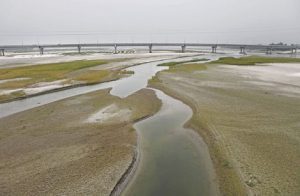In response to the Ukraine crisis, Europe’s leaders have recently called for an in-depth study of EU energy security, urging the EU Commission – the executive body – to produce a comprehensive plan for reducing energy dependency by June this year.
At a meeting of the EU Council in March, member states also agreed to “show solidarity” in case of sudden supply disruptions in one or several EU countries, and called for an acceleration of existing measures aimed at bolstering the union’s energy integration.
The renewed focus on energy security is hardly a surprise. Russia supplies about 30% of the EU’s gas, of which about half is piped through Ukraine. The current crisis raises important energy questions about the likelihood of a supply disruption or price spikes should Russia decide to turn off the taps supplying Ukraine (Putin has already warned of this possibility in a letter a letter to 18 European leaders.)
“We are in great uncertainty and trust [in Russia] has been shaken,” said German chancellor Angela Merkel at a press conference on energy and infrastructure, summing up the collective nerves of a continent.
The EU looks set once again to take stock of its energy sector, with important countries, such as Germany and Poland, calling for review of energy policy as a whole. But with opinion on climate and energy strategies sharply divided within Europe, what changes might we expect?
A greater role for gas
The significance of the June study for EU energy policy will depend on events in Ukraine over coming months. If tensions increase and materially affect Ukraine, and even the supply in some member states, we can anticipate a far reaching switch in policy priorities.
This would likely include the speeding up of plans for the construction of the Southern Gas Corridor, which will bring gas from the Caspian and Middle East to Europe. A statement from the EU-US Energy Council on April 2 “reaffirmed the importance of the Southern Gas Corridor to bring gas to Europe, urged for timely construction of a dedicated, scalable pipeline which keeps the options open for additional supplies.”
Even if tensions subside, however, this is the third time in a decade that Russia/Ukraine relations have threatened European energy supplies. It is therefore likely that gas diversification strategies will be at the fore come what may, with prioritisation given to gas pipeline projects in the Connecting Europe Facility, a platform to promote growth and jobs through infrastructure investment at EU level.
With many European politicians hoping to emulate the shale gas revolution in the United States, it is also likely that non-conventional gas production – or fracking – will receive further political support.
We will also likely see a renewed emphasis on domestic energy production, through the further support of the renewable energy target, tacit support for nuclear power and, potentially, reduced opposition to the ongoing use of coal.
There are dangers lurking here. In particular, gas security concerns may give a further push towards the use of coal. Already, the low carbon price and relatively cheap fuel costs have led to an increase in use of the fossil fuel in recent years. Further supply and therefore price uncertainty could accelerate this trend, raising questions about Europe’s credentials as a leader on climate action.
Climate change a declining priority
Already the EU – a longstanding champion in climate politics through policies to reduce its own emissions and its commitment to global action – has potentially weakened its focus on the task as it has fragmented into factions that strongly disagree over the path ahead.
Its climate change and energy package adopted in 2009 was viewed as a milestone in EU policy, as it set ambitious emissions-reduction targets for 2020, and introduced for the first time a clear alignment of the energy security and the decarbonisation agendas.
But the political and public conditions prior to the drafting of the 2009 package were significantly different from now. As a result of the Euro crisis, trust in EU institutions has declined, while climate change is no longer seen as the absolute priority. A subtle change in language from European Commission president José Manuel Barroso is a clue – in 2007, he stated that “Climate change is the greatest challenge of our generation.” By January this year, it had become only a “defining challenge”.
The key element of the EU’s proposed new climate package, which still needs final approval, is the greenhouse-gas target – that EU emissions must be 40% below 1990 levels by 2030, achieved through domestic action.
While this has been welcomed by figures including UNFCCC head Christiana Figueres, who called it a “positive signal” for a meaningful agreement at the UN-led climate change conference in Paris in 2015, environmental groups have noted that the 40% reduction target is by the Commission’s own analysis to be on a pathway that only has a 50% chance of keeping warming within the international target of 2 degrees C.
The EU Commission has also proposed an EU wide target of 27% for renewable energy by 2030, which would translate into 45% of the Union’s electricity coming from renewables by 2030, a level that would require radical changes in the way in which electricity is managed, stored and transmitted. But the proposal differs significantly from previous targets for renewable energy in that it would be binding on the EU as a whole and not on individual member states. This rather unusual system is a compromise between European countries that strongly support the continuation of the existing system, with a binding target, and those fundamentally opposed, because they want flexibility to choose the most effective and economical way of meeting their emissions goals.
No agreement was reached on the GHG target at the EU Spring Council, disappointing many. The majority called for the 40% target, but some, in particular certain central European states including Poland, remain opposed to a unilateral target at this stage. Instead, the Council proposed that a “final decision on the new policy framework [would be taken] as quickly as possible and no later than October 2014”. This potentially puts an end to the EU’s plan to attend the UN Secretary General’s Climate Summit in September with its target agreed.
The Ukraine crisis is an opportunity to create an EU energy policy which balances concerns around security, affordability and sustainability. But in the rush to address energy security concerns, it is important that climate policy objectives are not forgotten. Priority should be given to strategies that address both simultaneously, and the cheapest and most widely available option is energy efficiency.
Indeed, a new emphasis on energy efficiency may be the silver lining. A review of progress made by EU member states in meeting the requirements of the Energy Efficiency Directive will be published in June. If it is deemed inadequate, the current situation will add weight to calls for the introduction of a binding EU target.







